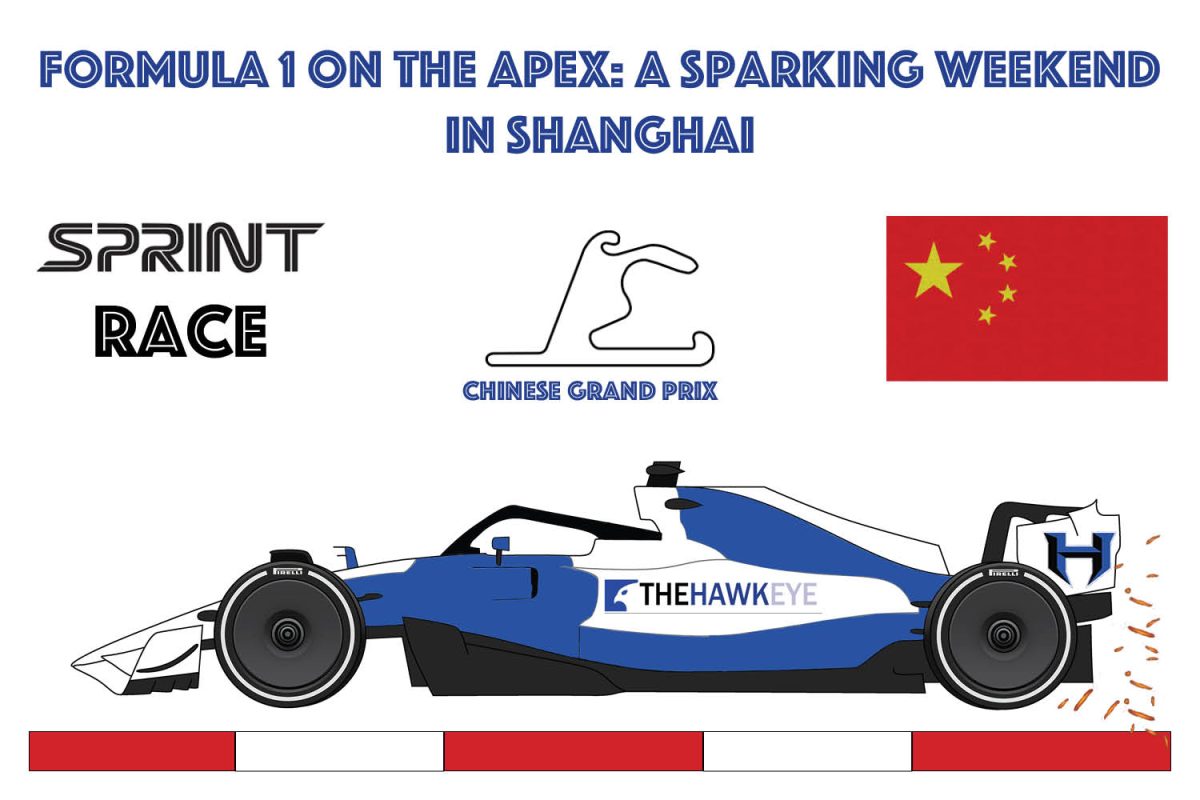After a spectacular weekend in Suzuka, the teams headed to Shanghai for the return of the Chinese Grand Prix.
Taken off the calendar in 2020, the Chinese Grand Prix returned after a five-year hiatus. The track is filled with twists and turns, and includes two long straights for overtaking. This specific track contains one of my favorite series of turns in all of Formula 1: the almost cinnamon roll-like combination of turns one, two, three and four. While looking visually stunning as the cars go through, it also allows for possibilities of many different racing lines.
Experience was a big factor for the weekend, as only 14 of the 20 drivers on the grid had driven the circuit before. For young drivers like Yuki Tsunoda, Oscar Piastri and Logan Sargent, it was their first time racing on the circuit. The Chinese Grand Prix, similar to the Japanese Grand Prix, had a driver featuring in their home race. This weekend, it was the young Kick Sauber driver Zhou Guanyu, who grew up around the area in Shanghai, and is the only Chinese driver to ever race in Formula 1.
The Chinese Grand Prix marks the first Sprint weekend of the calendar. For those who are unfamiliar with how a Sprint weekend works, things start normally as the drivers go out for a practice session (FP1) on Friday. However, after FP1, things started to get crazy when the drivers went into a short and quick qualifying formatted session called the Sprint Shootout.
The Sprint Shootout has a similar format to the qualifying format seen in regular race weekends, including Sprint Qualifying One (SQ1), SQ2 and SQ3. However, instead of the drivers being allowed to use whatever tire compound they want during qualifying, they are only allowed to use the medium tire for SQ1 and SQ2. In SQ3, they are allowed to use the soft tires again. With this format of qualifying, there is always room for shocking exits and drama to take place, and boy was there drama.
SQ1 started out normally with all drivers setting their initial laps. Tsunoda struggled after having an impressive start to the season and was subsequently knocked out in SQ1. Home favorite Guanyu and and his teammate Valteri Bottas were able to put their Kick Saubers into SQ2 and show there is hope. As SQ1 came to a close, sparks from a passing car suddenly lit the track on fire outside of turn five. I have never seen something like that happen in my seven years of watching Formula 1. It caused a break between SQ1 and SQ2, which also happened earlier in FP1 when the grass surrounding turn seven ignited into flames and caused a red flag.
SQ2 was also filled with a bit of drama as the sky darkened around the circuit, and drivers were experiencing light rain. This led to shocking exits from Mercedes driver George Russell and unexpected advances from both Kick drivers. Going into SQ3, the track became more and more damp, leading to big snaps of oversteer for all the drivers who struggled to find grip. Ferrari driver Charles Leclerc even had a moment where he spun into the wall early in SQ3. With the rain pouring down, McLaren driver Lando Norris managed to take provisional pole for the sprint race until Lewis Hamilton came in at the last second and took pole from him. The drama didn’t stop there. Norris’s previous lap time, which had been deleted due to track limits, was reinstated and he was once again put back in pole position.
With a dramatic Sprint Shootout coming to a close, the drivers set off to prepare for the Sprint race on Saturday. The sprint race is exactly what it sounds like; it’s similar to a sprint event in track and field. A normal race can be compared to a longer race like a marathon, and the sprint race is like the 200 meter sprint. The sprint race is only 19 laps long and almost guarantees some sort of action will happen, as the drivers constantly fight for positions.
The Sprint race did not disappoint; as the drivers raced down into turn one, Hamilton and Norris went wheel-to-wheel into the first set of corners. Hamilton managed to pull ahead into P1. Norris went off track and dropped all the way back into P7. Hamilton was able to keep first all the way up to lap nine, where Max Verstappen inevitably overtook him. Verstappen dominated the rest of the sprint and showed how dominant he and Red Bull have been in this season. The top eight drivers in the sprint took home some championship points, a podium finish for Verstappen in P1, Hamilton in P2 and Sergio Perez in P3.
Following the sprint race on Saturday, the drivers took a break before heading into the official qualifying sessions. In Q1, Tsunoda continued to struggle with the track and only managed to qualify P19. Shockingly, Hamilton, who after taking second in the sprint race, only managed to qualify in P18. In Q2, there weren’t many surprising exits other than Aston Martin driver Lance Stroll, who was barely beaten out by Bottas. In Q3, Verstappen dominated, once again taking pole position with his teammate Perez close behind in second. Surprisingly though, Alonso managed to get his Aston all the way up into third place on the grid.
One of the things I hate but also love the most about Formula 1 is how broad of a sport it is. They travel the world and go to places I could only dream of, but this also means that since races are happening halfway across the world, they take place at times like 2 a.m. I decided not to watch this race live and get some sleep.
I regret that choice.
The race did not disappoint. As it was ‘lights out and away we go’ for the fifth time this season, Verstappen got out to an early lead and Alonso managed to jump Perez for P2, heading into the first series of corners. Both Ferraris struggled off the line and dropped some positions. Hamilton managed to gain one position on his climb toward the points scoring positions. The race was a bit dull leading up to lap 20 — aside from Norris making moves up into third. However, on lap 20, a wrench was thrown into the works. Bottas suffered an engine failure and was stranded on the side of the track, which was a hard area for the race marshals to retrieve his car safely. The Virtual Safety Car (VSC) was called out for three laps, meaning the drivers are forced to slow down and stay under a predetermined time delta or receive a penalty. After the VSC was out for the three laps, the race officials decided that a full Safety Car was needed.
Everything really kicked off when the Safety Car came in on lap 27. Before anything could even get fully underway, Stroll, seemingly unaware of his surroundings, barrelled into the back of Daniel Riccardo’s RB under the safety car. Stroll got front wing damage and was forced to pit and Riccardo was left with damage to the underside of the car. The drama didn’t stop there as soon after Haas driver Kevin Magnussen took out Tsunoda as the two collided. Magnussen was given a ten second time penalty and a second safety car was called.
The second safety car of the race thankfully only lasted until lap 31. Sadly for Riccardo, he was forced to retire his car shortly after the restart on lap 34. This was a race that was looking good for him as he was in a prime position to score his first points of the season.
Hamilton continued to crawl his way back up the standings and ended up finishing P9 and in the points. Lando went on to pass Perez and finished in P2 with Perez rounding out the podium. Alonso dropped down to P7 following a strategy mishap, and Verstappen, once again, took the checkered flag as he dominated the field and finished 15 seconds ahead of Norris.
All in all, the first sprint race weekend of the year was as interesting as it could get. The Chinese Grand Prix definitely made a spectacular return and I can’t wait to see more races in Shanghai in the future.










